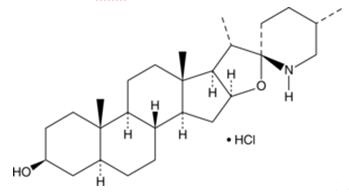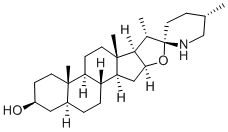Tomatidine – a natural small molecule from tomato plants
Tomatidine is the aglycone derivative of tomatine. Tomatidine belongs to the chemical family known as Spirosolanes and Derivatives. These are steroidal alkaloids whose structure contains a spirosolane skeleton. Tomatine (the glycosylated form of tomatidine) is a mildly toxic glycoalkaloid or glycospirosolane found in the stems and leaves of tomato plants as well as in the fruit of unripened (green) tomatoes (up to 500 mg/kg). Red, ripe tomatoes have somewhat reduced amounts of tomatine and tomatidine. Both tomatine and tomatidine possess antimicrobial, antifungal and antiviral properties.
Tomatidine has been shown to exhibit anti-virulence activity against normal strains of Staphylococcus aureus as well as the ability to potentiate the effect of aminoglycoside antibiotics. Recent studies have shown that tomatidine stimulates mTORC1 signaling and anabolism, leading to accumulation of protein and mitochondria, and ultimately, cell growth. Furthermore, in mice, tomatidine has been shown to increase skeletal muscle mTORC1 signaling, reduce skeletal muscle atrophy, enhance recovery from skeletal muscle atrophy, stimulate skeletal muscle hypertrophy, and increase strength and exercise capacity. Tomatidine has also been shown to significantly inhibit cholesterol ester accumulation induced by acetylated LDL in human monocyte-derived macrophages in a dose-dependent manner. Tomatidine also inhibits cholesterol ester formation in Chinese hamster ovary cells overexpressing acyl-CoA:cholesterol acyl-transferase (ACAT)-1 or ACAT-2, suggesting that tomatidine suppresses both ACAT-1 and ACAT-2 activities. The oral administration of tomatidine to apoE-deficient mice significantly reduces levels of serum cholesterol, LDL-cholesterol, and the size of atherosclerotic lesions [1].

Tomatidine is a steroidal alkaloid that has been found in the skins and leaves of tomatoes [2]. It suppresses NF-κB signaling in LPS-stimulated macrophages, blocking induced expression of inducible nitric oxide synthase (iNOS) and COX-2. Tomatidine inhibits acid sphingomyelinase activity by 84.2% when used at a concentration of 10 mM. It also has antibacterial properties, preferentially blocking the replication of S. aureus variants that are pathogenic in cystic fibrosis over normal strains (MICs = 0.12 and >16 µg/ml, respectively). It prevents skeletal muscle atrophy associated with fasting or spinal cord injury in mice. Tomatidine has also been used as a negative control for cyclopamine in studies involving signaling mediated by the hedgehog pathway.
Tomatidine is derived from tomatoes - but not the luscious, red, ripe ones we buy from stores. Instead, tomatidine is found in greater quantities in green tomatoes and is produced when alpha-tomatine is digested in the gut. One of the best features tomatidine boasts is that it’s beneficial to your health - and the same can’t be said for a number of other anabolic supplements you may find available. One study, conducted in 2012, demonstrated how tomatidine and another alkaloid found in tomatoes (esculeogenin-A) can reduce cholesterol uptake in human macrophages (types of white blood cells that are responsible for recognizing and “eating” foreign bodies in our blood vessels). Scientists discovered that tomatidine has some of the similar cancer-fighting properties that lycopene has, which definitely warrants more research and human-based studies to see just how advantageous it may be [3].
Skeletal muscle atrophy is a common and debilitating condition that lacks an effective therapy. To address this problem, Michael C. Dyle etc. used a systems-based discovery strategy to search for a small molecule whose mRNA expression signature negatively correlates to mRNA expression signatures of human skeletal muscle atrophy. This strategy identified a natural small molecule from tomato plants, tomatidine. Using cultured skeletal myotubes from both humans and mice, they found that tomatidine stimulated mTORC1 signaling and anabolism, leading to accumulation of protein and mitochondria, and ultimately, cell growth. Furthermore, in mice, tomatidine increased skeletal muscle mTORC1 signaling, reduced skeletal muscle atrophy, enhanced recovery from skeletal muscle atrophy, stimulated skeletal muscle hypertrophy, and increased strength and exercise capacity. Collectively, these results identify tomatidine as a novel small molecule inhibitor of muscle atrophy. Tomatidine may have utility as a therapeutic agent or lead compound for skeletal muscle atrophy [4].
References
[1] https://pubchem.ncbi.nlm.nih.gov/compound/Tomatidin
[2] Chiu, F.L., and Lin, J.K. Tomatidine inhibits iNOS and COX-2 through suppression of NF-κB and JNK pathways in LPS-stimulated mouse macrophages. FEBS Letters 582(16), 2407-2412 (2008).
[3] https://www.predatornutrition.com/articlesdetail?cid=tomatidine-supplement
[4] Michael C. Dyle, Scott M. Ebert, Daniel P. Cook, Steven D. Kunkel, Daniel K. Fox, Kale S. Bongers, Steven A. Bullard, Jason M. Dierdorff, and Christopher M. Adams, Systems-based Discovery of Tomatidine as a Natural Small Molecule Inhibitor of Skeletal Muscle Atrophy, THE JOURNAL OF BIOLOGICAL CHEMISTRY VOL. 289, NO. 21, pp. 14913–14924, May 23, 2014.
[5] http://www.chemspider.com/Chemical-Structure.59019.html?rid=65c4eac9-5647-4add-9892-bf43e2d81542
[6] https://pubs.acs.org/doi/10.1021/jf204197r
You may like
See also
Lastest Price from TOMATIDINE manufacturers

US $0.00/mg2023-02-24
- CAS:
- 77-59-8
- Min. Order:
- 5mg
- Purity:
- ≥98%(HPLC)
- Supply Ability:
- 10 g

US $15.00-10.00/KG2021-07-02
- CAS:
- 77-59-8
- Min. Order:
- 1KG
- Purity:
- 99%+ HPLC
- Supply Ability:
- Monthly supply of 1 ton


